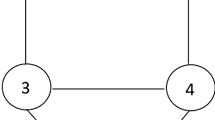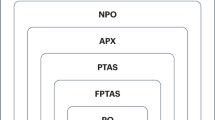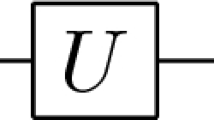Abstract
Quantum Bridge Analytics relates generally to methods and systems for hybrid classical-quantum computing, and more particularly is devoted to developing tools for bridging classical and quantum computing to gain the benefits of their alliance in the present and enable enhanced practical application of quantum computing in the future. This is the first of a two-part tutorial that surveys key elements of Quantum Bridge Analytics and its applications, with an emphasis on supplementing models with numerical illustrations. In Part 1 (the present paper) we focus on the Quadratic Unconstrained Binary Optimization model which is presently the most widely applied optimization model in the quantum computing area, and which unifies a rich variety of combinatorial optimization problems.



Similar content being viewed by others
Explore related subjects
Discover the latest articles, news and stories from top researchers in related subjects.Notes
This adds a constant to the QUBO model, which is irrelevant for optimization.
Reference to quantum computing would not be complete without mentioning Google’s recent claim to achieving ‘quantum supremacy.’ This outcome has no bearing on the computational considerations discussed here. See, for example Preskill (2019).
References
Ailon N, Charikar M, Newman A (2008) Aggregating inconsistent information: ranking and clustering. J ACM (JACM) 55(5):23
Aimone JB, Hamilton KE, Mniszewsk S, Reeder L, Schuman CD, Severa WM (2018) Non-neural network applications for spiking neuromorphic hardware. In: PMES workshop
Albash T, Lidar DA (2015) Decoherence in adiabatic quantum computation. Phys Rev A 91: 062320. arXiv:1503.08767v2
Albash T, Hen I, Spedalieri FM, Lidar DA (2015) Reexamination of the evidence for entanglement in the D-Wave processor. Phys Rev A 92:62328. arXiv:1506.03539v2
Aliadee B, Glover F, Kochenberger G, Rego C (2005) A new modeling and solution approach for the number partitioning problem. Appl Math Decis Sci 9(2):135–145
Alidaee B, Kochenberger G, Lewis K, Lewis M, Wang H (2008) A new approach for modeling and solving set packing problems. Eur J Oper Res 186(2):504–512
Aloise D, Cafieri S, Caporossi G, Hansen P, Perron S, Liberti L (2010) Column generation algorithms for exact modularity maximization in networks. Phys Rev E 82(4):046112
Alom MZ, Van Essen B, Moody AT, Widemann DP, Taha TM (2017) Quadratic unconstrained binary optimization (QUBO) on neuromorphic computing system. In: IEEE 2017 international joint conference on neural networks (IJCNN). https://doi.org/10.1109/ijcnn.2017.7966350
Alpha-QUBO (2019). http://meta-analytics.net/Home/AlphaQUBO
Amin MHS, Truncik CJS, Averin DV (2008) Role of single qubit decoherence time in adiabatic quantum computation. Phys Rev A 80: 022303. arXiv:0803.1196v2
Anthony M, Boros E, Crama Y, Gruber A (2017) Quadratic reformulations of nonlinear binary optimization problems. Math Program 162(1–2):115–144
Aramon M, Rosenberger G, Valiante E, Miyazawa T, Tamura H, Katzgraber HG (2019) Physics-inspired optimization for quadratic unconstrained problems using a digital annealer. Front Phys 7:48
Berwald JJ, Gottlieb JM, Munch E (2018) Computing Wasserstein distance for persistence diagrams on a quantum computer. arXiv:1809.06433
Boixo S, Rønnow TF, Isakov SV, Wang Z, Wecker D, Lidar DA, Martinis JM, Troyer M (2014) Evidence for quantum annealing with more than one hundred qubits. Nat Phys 10:218–224
Boros E, Hammer P (1991) The max-cut problem and quadratic 0–1 optimization: polyhedral aspects, relaxations and bounds. Ann Oper Res 33(3):151–180
Boros E, Hammer P (2002) Pseudo-boolean optimization. Discrete Appl Math 123(1):155–225
Boros E, Hammer PL, Sun R, Tavares G (2008) A max-flow approach to improved lower bounds for quadratic unconstrained binary optimization (QUBO). Discrete Optim 5(2):501–529
Chapuis G, Djidjev H, Hahn G, Rizk G (2018) Finding maximum cliques on the D-wave quantum annealer. J Signal Process Syst. https://doi.org/10.1007/s11265-018-1357-8
Clark J, West T, Zammit J, Guo X, Mason L, Russell D (2019) Towards real time multi-robot routing using quantum computing technologies. In: HPC Asia 2019 proceedings of the international conference on high performance computing in Asia-Pacific region, pp 111–119
Date P, Patton R, Schuman C, Potok T (2019) Efficiently embedding QUBO problems on adiabatic quantum computers. Quantum Inf Process 18:117. https://doi.org/10.1007/s11128-019-2236-3
Debenedictis EP (2019) A future with quantum machine learning. IEEE Comput Edge 5(3):24–27
Elsokkary N, Khan FS, Humble TS, Torre DL, Gottlieb J (2017) Financial portfolio management using D-wave, quantum optimizer: the case of abu dhabi securities exchange. In: 2017 IEEE high-performance extreme computing (HPEC)
Farhi E, Goldstone J (2014) A quantum approximate optimization algorithm. arXiv:1411.4028
Feld S, Roch C, Gabor T, Seidel C, Neukart F, Galter I, Mauerer W, Linnhoff-Popien C (2018) A hybrid solution method for the capacitated vehicle routing problem using a quantum annealer. arXiv:1811.07403
Glover F (1996) Tabu search and adaptive memory programming–advances, applications and challenges. In: Barr RS, Helgason RV, Kennington JL (eds) Interfaces in computer science and operations research. Kluwer Academic Publishers, Springer, pp 1–75
Glover F (1997) A template for scatter search and path relinking, in artificial evolution. In: Hao JK, Lutton E, Ronald E, Schoenauer M, Snyers D (eds) Lecture notes in computer science, vol 1363. Springer, pp 13–54
Glover F, Kochenberger G (2019) Quantum bridge analytics & QUBO 2.0. In: Quantum insight conference 2019, invited presentation 10/04/19, LHOFT—Luxembourg House of Financial Technology, 9, rue du Laboratoire, Luxembourg
Glover F, Laguna M (1997) Tabu search. Kluwer Academic Publishers, Boston
Glover F, Mulvey J, Bai D, Tapia M (1998) Integrative population analysis for better solutions to large-scale mathematical programs. In: Yu G (ed) Industrial applications of combinatorial optimization. Kluwer Academic Publishers, Boston, pp 212–237
Glover F, Kochenberger G, Alidaee B, Amini M (2002) Solving quadratic knapsack problems by reformulation and tabu search. In: Pardalos PM, Megados A, Burkard R (eds) Combinatorial and global optimization. World Scientific Publishing Co., Singapore, pp 272–287
Glover F, Kochenberger G, Wang Y (2018a) A new QUBO model for unsupervised machine learning. Res Prog (work in progress)
Glover F, Lewis M, Kochenberger G (2018b) Logical and inequality implications for reducing the size and difficulty of unconstrained binary optimization problems. Eur J Oper Res 265(2018):829–842
Hahn G, Djidjev H (2017) Reducing binary quadratic forms for more scalable quantum annealing. In: 2017 IEEE international conference on rebooting computing. https://doi.org/10.1109/ICRC.2017.8123654
Hamilton K, Schuman CD, Young SR, Imam N, Humble TS (2018) Neural networks and graph alogrithms with next-generation processors. In: 2018 IEEE international parallel and distributed processing symposium workshops (IPDPSW). https://doi.org/10.1109/IPDPSW.2018.00184
Hoos HH (2012) Programming by optimization. Commun ACM 55(2):70–80
Kalra A, Qureshi F, Tisi M (2018) Portfolio asset identification using graph algorithms on a quantum annealer. http://www.henryyuen.net/fall2018/projects/qfinance.pdf
Kerberos (2019) The network authentication protocol. https://web.mit.edu/kerberos/
Kochenberger G, Glover F (2006) A unified framework for modeling and solving combinatorial optimization problems: a tutorial. In: Hager W, Huang SJ, Pardalos P, Prokopyev O (eds) Multiscale optimization methods and applications. Springer, Berlin, pp 101–124
Kochenberger G, Glover F, Alidaee B, Lewis K (2005a) Using the unconstrained quadratic program to model and solve Max 2-Sat problems. Int J OR 1(1):89–100
Kochenberger G, Glover F, Alidaee B, Rego C (2005b) An unconstrained quadratic binary programming approach to the vertex coloring problem. Ann OR 139(1–4):229–241
Kochenberger G, Hao J-K, Lu S, Wang H, Glover F (2013) Solving large scale max cut problems via tabu search. J Heuristics 19(4):565–571
Kochenberger G, Hao J-K, Glover F, Lewis M, Lu Z, Wang H, Wang Y (2014) The unconstrained binary quadratic programming problem: a survey. J Comb Optim 28(1):58–81
Kochenberger G, Badgett A, Chawla R, Glover F, Wang Y, Du Y (2019) Comparison of QAOA and alpha QUBO algorithms (work in progress)
Lanting AJ, Przybysz A, Smirnov Y, Spedalieri FM, Amin MH, Berkley AJ, Harris R, Altomare F, Boixo S, Bunyk P, Dickson N, Enderud C, Hilton JP, Hoskinson E, Johnson MW, Ladizinsky E, Ladizinsky N, Neufeld R, Oh T, Perminov I, Rich C, Thom MC, Tolkacheva E, Uchaikin S, Wilson AB, Rose G (2014) Entanglement in a quantum annealing processor. Phys Rev X 4:021041. arXiv:1401.3500v1
Lewis M (2008) A new modeling and solution approach for the set partitioning problem. Comput OR 35(3):807–813
Lucas A (2014) Ising formulations of many NP problems. Front Phys 5:2. arXiv:1302.5843
Mniszewski S, Negre C, Ushijima-Mwesigwa H (2016) Graph partitioning using the D-wave for electronic structure problems. LA-UR-16-27873, pp 1–21
Mniszewski SM, Negre CFA, Ushijima-Mwesigwa (2018) Graph clustering approaches using near term quantum computing. In: Argonne quantum computing workshop
Negre CFA, Ushijima-Mwesigwa H, Mniszewsk SM (2019) Detecting multiple communities using quantum annealing on the D-wave system. arXiv:1901.09756
Neukart F, Compostella G, Seidel C, Dollen D, Yarkoni S, Parney B (2017) Traffic flow optimization using a quantum annealer. arXiv:1708.01625
Ohzeki M, Miki A, Miyama MJ, Terabe M (2018) Control of automated guided vehicles without collision by quantum annealer and digital devices. arXiv:1812.01532
Oliveira NMD, Silva RMDA, Oliveira WRD (2018) QUBO formulation for the contact map overlap problem. Int J Quantum Inf 16(8):1840007
O’Malley D, Vesselinov VV, Alexandrov BS, Alexandrov LB (2018) Nonnegative/binary matrix factorization with a D-Wave quantum annealer. PLoS ONE 13(12):e0206653. https://doi.org/10.1371/journal.pone.0206653
Pakin S (2017) Navigating a maze using a quantum annealer. In: Proceedings of the second international workshop on post Moores era supercomputing, pp 30–36
Pakin S (2018) QMASM–quantum macro assembler. https://ccsweb.lanl.gov/~pakin/software/; https://github.com/lanl/qmasm
Pardalos P, Xue J (1999) The maximum clique problem. J Glob Optim 4(3):301–328
Pelofske E, Hahn G, Djidjev H (2019) Solving large Maximum Clique problems on a quantum annealer. arXiv:1901.07657
Preskill J (2019) Why i called it “quantum supremacy, quanta magazine. https://www.quantamagazine.org/john-preskill-explains-quantum-supremacy-20191002/
Pudenz KL, Lidar DA (2013) Quantum adiabatic machine learning. Quantum Inf Process 12(5):2027–2070
Qbsolv (2017) D-Wave initiates open quantum software environment. www.dwavesys.com/press-releases/d-wave-initiates-open-quantum-software-environment
Reedy C (2017) When will quantum computers be consumer products? Futurism. https://futurism.com/when-will-quantum-computers-be-consumer-products
Reinhardt S (2018) Detecting lateral movement with a compute-intense graph kernel. http://www.clsac.org/uploads/5/0/6/3/50633811/reinhardt-clsac-2018.pdf
Rodriguez-Heck E (2018) Linear ad quadratic reformulations of nonlinear optimization problems in binary variables. Ph.D. Dissertation, Liege University
Rosenberg I (1975) Reduction of bivalent maximization to the quadratic case. Cahiers du Centre d’Etudes de Recherche Operationnelle 17:71–74
Sahner D (2018) A potential role for quantum annealing in the enhancement of patient outcomes?. https://www.dwavesys.com/sites/default/files/Sahner.2018.pdf
Samorani M, Wang Y, Wang Y, Lv Z, Glover F (2019) Clustering-Driven evolutionary algorithms: an application of path relinking to the quadratic unconstrained binary optimization problem. J Heuristics 25(4–5):629–642
Schneidman E, Berry MJ, Segev R, Bialek W (2006) Weak pairwise correlations imply strongly correlated network states in a neural population. Nature 440(7087):1007–1012
Shaydulin R, Ushijima-Mwesigwa H, Safro I, Mniszewski S, Alexeev Y (2018) Community detection across emerging quantum architectures. In: PMES workshop
The National Academies of Sciences, Engineering and Medicine Consensus Study Report (2019) Quantum computing: progress and prospects. https://www.nap.edu/catalog/25196/quantum-computing-progress-and-prospects
Ushijima-Mwesigwa H, Negre CFA, Mniszewsk SM (2017) Graph partitioning using quantum annealing on the D-wave system. arXiv:1705.03082
Verma A, Lewis M (2019) Optimal quadratic reformulations of fourth degree Pseudo-Boolean functions. Optim Lett. https://doi.org/10.1007/s11590-019-01460-7
Vyskocil T, Pakin S, Djidjev HN (2019) Embedding inequality constraints for quantum annealling optimization, quantum technology and optimization problems. QTOP 2019. Lecture notes in computer science, vol 11413. Springer
Wang Q, Abdullah T (2018) An introduction to quantum optimization approximation algorithm. https://www.cs.umd.edu/class/fall2018/cmsc657/projects/group_16.pdf
Wang Y, Lu Z, Glover F, Hao J-K (2012) Path relinking for unconstrained binary quadratic programming. Eur J Oper Res 223(3):595–604
Wang Y, Lu Z, Glover F, Hao J-K (2013) Backbone guided tabu search for solving the UBQP problem. J Heuristics 19(4):679–695
Wang H, Wang Y, Resende M, Kochenberger G (2016) A QUBO approach to solving QAP problems (unpublished manuscript)
Yu H, Huang Y, Wu B (2018) Exact equivalence between quantum adiabatic algorithm and quantum circuit algorithm. arXiv: 1706.07646v3 [quant-ph], https://doi.org/10.1088/0256-307X/35/11/110303
Zhou L, Wang S, Choi S, Pichler H, Lukin MD (2018) Quantum approximate optimization algorithm: performance, mechanism, and implementation on near-term devices. arXiv:1812.01041
Acknowledgements
This tutorial was influenced by our collaborations on many papers over recent years with several colleagues to whom we owe a major debt of gratitude. These co-workers, listed in alphabetical order, are: Bahram Alidaee, Dick Barr, Andy Badgett, Rajesh Chawla, Yu Du, Jin-Kao Hao, Mark Lewis, Karen Lewis, Zhipeng Lu, Abraham Punnen, Cesar Rego, Yang Wang, Haibo Wang and Qinghua Wu. Other collaborators whose work has inspired us are too numerous to mention. Their names may be found listed as our coauthors on our home pages.
Author information
Authors and Affiliations
Corresponding author
Ethics declarations
Conflict of interest
The authors declare that they have no conflict of interest.
Additional information
Publisher's Note
Springer Nature remains neutral with regard to jurisdictional claims in published maps and institutional affiliations.
Rights and permissions
About this article
Cite this article
Glover, F., Kochenberger, G. & Du, Y. Quantum Bridge Analytics I: a tutorial on formulating and using QUBO models. 4OR-Q J Oper Res 17, 335–371 (2019). https://doi.org/10.1007/s10288-019-00424-y
Received:
Revised:
Published:
Issue Date:
DOI: https://doi.org/10.1007/s10288-019-00424-y
Keywords
- Quadratic Unconstrained Binary Optimization (QUBO)
- Quantum computing
- Quantum Bridge Analytics
- Combinatorial optimization




